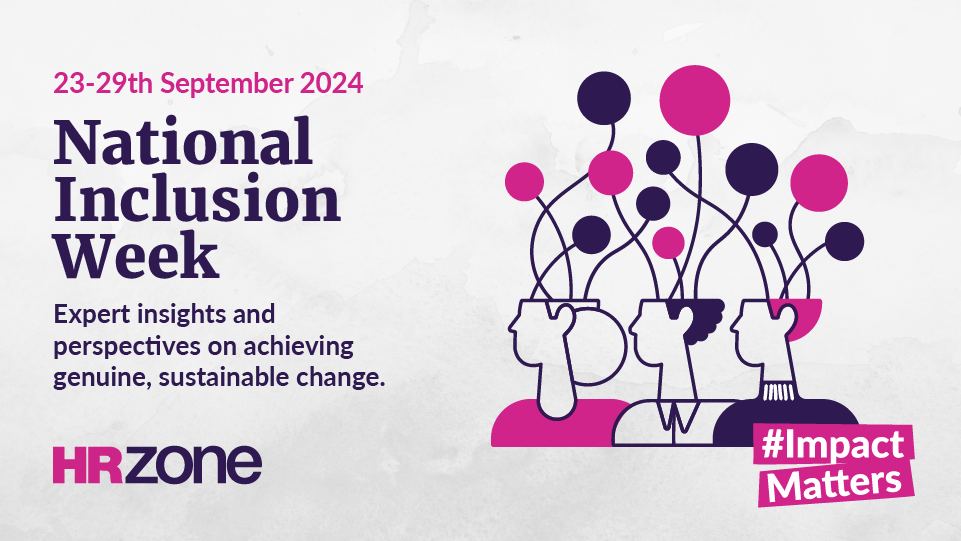This article is part of an HRZone series recognising National Inclusion Week 2024: #ImpactMatters
The modern workforce values inclusion, and as an employer, you should too.
Too often, wellbeing programmes miss the mark when it comes to addressing the needs of all employees. If you’re ready to make a meaningful impact within your organisation—where every employee feels seen, heard, and respected—this guide is for you.
Step one – take a hard look at your current wellbeing programme
Take a look at what you currently have in place (if there is nothing there, then you need to get moving.)
The best way to analyse whether your existing wellbeing programme is hitting the mark is to talk to your people. Push for open and honest communication among your workforce. This will help you get an understanding of your employee’s experiences.
What will they need to feel seen and heard at work?
You can do this through setting up one one-on-ones to discuss where employees may feel underrepresented. You can also distribute company-wide surveys which focus on employee wellbeing and workplace inclusion.
If obvious gaps or trends begin to emerge, then you need to ask your employees: ‘what can we do to make it better for you?’ An inclusive wellbeing programme should be co-created with the employees it aims to serve, therefore collecting feedback is crucial.
One size never fits all!
It really doesn’t. Mental health resources for disabled employees will be vastly different to those for LGBTQ+ employees. Resources need diversity and they need to be specific for different groups.
Have you thought about your working parents or employees with caring responsibilities? Flexible working schedules are often massively beneficial when traditional working hours are tricky with busy home lives.
What about your neurodiverse employees? What will they need to feel seen and heard at work? Employees on the autism spectrum often benefit from calm, low-lighting office environments. Dyslexic employees will be more comfortable handling visual tasks as opposed to lengthy documents.
There’s lots to think about so understanding who your people are and what they need from you is essential.
How accessible is your new programme?
Global offices will often have employees from all over the world. So, if the content of your wellbeing programme is presented only in English, this immediately causes problems.
Furthermore, deaf employees will need subtitles, captions or interpreters, and blind employees will need braille, voice-overs or assistive tools.
This is just one example of accessibility. Other barriers, such as technology or physical access, can present hurdles which should be addressed. Ensure your workforce is properly trained to navigate wellbeing initiatives and that the programme is adapted for disabled employees as well.
Place wellbeing at the forefront of your strategy (all four pillars!)
Effective wellbeing strategies highlight the importance of the four pillars of wellbeing: mental, physical, financial and social welllbeing.
All too often, companies will offer a gym member, or provide fruit in the staff room…this isn’t enough and hardly makes a dent in the spectrum of wellbeing.
Make a clear plan and stick to it.
Ideas for an inclusive wellbeing strategy that hit all pillars include:
- Mental wellbeing: Stress management coaching, counselling, flexible working.
- Physical wellbeing: Walking meetings, step count challenges, healthy breakfasts.
- Financial wellbeing: Finance management and retirement workshops.
- Social wellbeing: Consistent and varied team-building events (that don’t always include alcohol – remember, not everyone drinks!)
Update your strategy
The working world is constantly transforming. In the space of a few years, hybrid and remote working has replaced traditional nine-to-five roles as the new normal. Big shifts in the corporate landscape are to be expected, and successful leaders are those who can bend to fit these new spaces.
Review your strategy on a regular basis. This means checking in with your workforce every few months to ensure your strategy is working. Talk to your people and assess if employees are utilising the programme. If your programme is largely untouched, this is a strong indicator that you need to rethink.
If the resources are available to you, form a wellbeing team dedicated to assessing the success of your programme. A happy, thriving team is a productive one where your business will reap the benefits.
Budgeting tips
Building an inclusive wellbeing programme doesn’t have to bankrupt your business, but certainly requires some care and thought towards budgeting.
This task is much easier once you understand what groups require the most support, and what areas need the most attention.
Consider the following:
- Reallocating funds from less effective benefits (such as free office snacks, seasonal gift cards…)
- Explore partnerships with external providers for cost-efficient wellbeing services (i.e. Headspace, Gympass, Nudge, Unmind…)
- Leverage internal resources (do any of your employees have mental health, financial health or physical health training? Could they lead workshops?)
Make a clear plan and stick to it.
Final thoughts
We spend so much of our lives at work; dedicating hours to business tasks and meetings. This means that employee wellbeing must be a priority for everyone involved. An inclusive wellbeing programme is an essential part of creating a human-centred workplace that acknowledges the diverse needs of teams.
When employees are well, they bring their best selves to work, and that is what UK businesses should be striving for.
Further reading and resources
- CIPD – Creating an Inclusive Workplace
- Mental Health Foundation – How to Support Mental Health at Work
- ACAS – Health and Wellbeing at Work
- Global Wellness Institute: Financial Wellbeing







